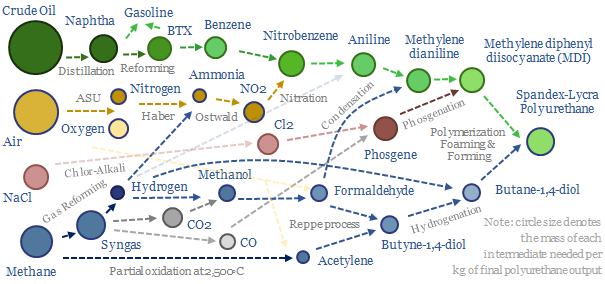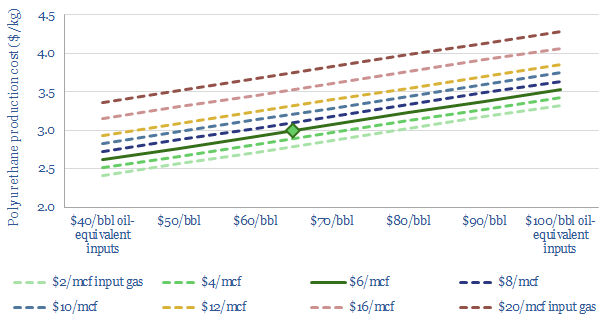Polyurethane production costs are estimated at $2.5-3.0/kg in our base case model, which looks line-by-line across the inputs and outputs, of a complex, twenty stage production process, which ultimately yields spandex-lycra fibers. Costs depend on oil, gas and hydrogen input prices.
Polyurethane production costs are complex to model, because there are over 20 intermediate stages when transforming oil, gas, air and mined minerals into this class of petrochemicals (chart below). And moreover, there are hundreds of different types of polyurethanes, in this 25MTpa market, which comprises c5% of all plastics.

This data-file builds up the mass balances for spandex-lycra polyurethanes, going line by line through this complex value chain, and drawing on our other models.
Our base case estimate is for polyurethane production costs of $2.5-3.0/kg, although costs are sensitive to oil, gas and hydrogen prices, as shown overleaf.
To reach these numbers, we have simply captured the mass balances of different products in the supply chains, and then drawn on our library of other economic models to add other costs associated with gas value chains, naphtha cracking, air separation, hydrogen production, chemical separations, CO2 separation, ammonia synthesis, nitric acid, methanol, formaldehyde, chlor-alkali, acetylene et al.
Can you use green hydrogen to decarbonize polyurethane? Substituting 0.12 kg of grey hydrogen per kg of polyurethane (at 9 tons of CO2 per ton of H2) with low carbon hydrogen saves a full 1 kg of CO2 per kg of polyurethane. However at $7-10/kg green hydrogen prices, this also inflates the polyurethane price by around $0.8-1.2/kg. Conversely, using US blue hydrogen can avoid similar CO2 emissions with minimal reinflation. This illustrates that there may be growing upside in blue chemicals, alongside other blue hydrogen themes.
It is a lot to capture. And hence we hope users of this model will find the big-picture sensitivity analysis of polyurethane production costs useful; including the ability to flex the inputs, which in turn can be interrogated by diving into our other economic models. For further details please see our outlook for polyurethane in the energy transition.

